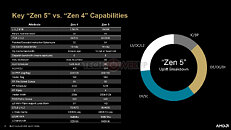- Joined
- Oct 9, 2007
- Messages
- 47,670 (7.43/day)
- Location
- Dublin, Ireland
| System Name | RBMK-1000 |
|---|---|
| Processor | AMD Ryzen 7 5700G |
| Motherboard | Gigabyte B550 AORUS Elite V2 |
| Cooling | DeepCool Gammax L240 V2 |
| Memory | 2x 16GB DDR4-3200 |
| Video Card(s) | Galax RTX 4070 Ti EX |
| Storage | Samsung 990 1TB |
| Display(s) | BenQ 1440p 60 Hz 27-inch |
| Case | Corsair Carbide 100R |
| Audio Device(s) | ASUS SupremeFX S1220A |
| Power Supply | Cooler Master MWE Gold 650W |
| Mouse | ASUS ROG Strix Impact |
| Keyboard | Gamdias Hermes E2 |
| Software | Windows 11 Pro |
AMD in its architecture deep-dive Q&A session with the press, confirmed that the "Zen 5" and "Zen 5c" cores on the "Strix Point" silicon only feature 256-bit wide FPU data-paths, unlike the "Zen 5" cores in the "Granite Ridge" Ryzen 9000 desktop processors. "The Zen 5c used in Strix has a 256-bit data-path, and so does the Zen 5 used inside of Strix," said Mike Clark, AMD corporate fellow and chief architecture of the "Zen" CPU cores. "So there's no delta as you move back and forth [thread migration between the Zen 5 and Zen 5c complexes] in vector throughput," he added.
It doesn't seem like AMD disabled a physically available feature, but rather, the company developed a variant of both the "Zen 5" and "Zen 5c" cores that physically lack the 512-bit data-paths. "And you get the area advantage to be able to scale out a little bit more," Clark continued. This suggests that the "Zen 5" and "Zen 5c" cores on "Strix Point" are physically smaller than the ones on the 4 nm "Eldora" 8-core CCD that is featured in "Granite Ridge" and some of the key models of the upcoming 5th Gen EPYC "Turin" server processors.


One of the star-attractions of the "Zen 5" microarchitecture is its floating-point unit, which supports AVX512 with a full 512-bit data path. In comparison, the previous-generation "Zen 4" handled AVX512 using a dual-pumped 256-bit FPU. The new 512-bit FPU, depending on the exact workload and other factors, is about 20-40% faster than "Zen 4" at 512-bit floating-point workloads, which is why "Zen 5" is expected to post significant gains in AI inferencing performance, as well as plow through benchmarks that use AVX512.
We're not sure how the lack of a 512-bit FP data-path affects performance of instructions relevant to AI acceleration, since "Strix Point" is mainly being designed for Microsoft Copilot+ ready AI PCs. It's possible that AVX512 and AVX-VNNI are being run on a dual-pumped 256-bit data-path similar to how it is done on "Zen 4." There could be some performance/Watt advantages to doing it this way, which could be relevant to mobile platforms.
View at TechPowerUp Main Site
It doesn't seem like AMD disabled a physically available feature, but rather, the company developed a variant of both the "Zen 5" and "Zen 5c" cores that physically lack the 512-bit data-paths. "And you get the area advantage to be able to scale out a little bit more," Clark continued. This suggests that the "Zen 5" and "Zen 5c" cores on "Strix Point" are physically smaller than the ones on the 4 nm "Eldora" 8-core CCD that is featured in "Granite Ridge" and some of the key models of the upcoming 5th Gen EPYC "Turin" server processors.


One of the star-attractions of the "Zen 5" microarchitecture is its floating-point unit, which supports AVX512 with a full 512-bit data path. In comparison, the previous-generation "Zen 4" handled AVX512 using a dual-pumped 256-bit FPU. The new 512-bit FPU, depending on the exact workload and other factors, is about 20-40% faster than "Zen 4" at 512-bit floating-point workloads, which is why "Zen 5" is expected to post significant gains in AI inferencing performance, as well as plow through benchmarks that use AVX512.
We're not sure how the lack of a 512-bit FP data-path affects performance of instructions relevant to AI acceleration, since "Strix Point" is mainly being designed for Microsoft Copilot+ ready AI PCs. It's possible that AVX512 and AVX-VNNI are being run on a dual-pumped 256-bit data-path similar to how it is done on "Zen 4." There could be some performance/Watt advantages to doing it this way, which could be relevant to mobile platforms.
View at TechPowerUp Main Site





